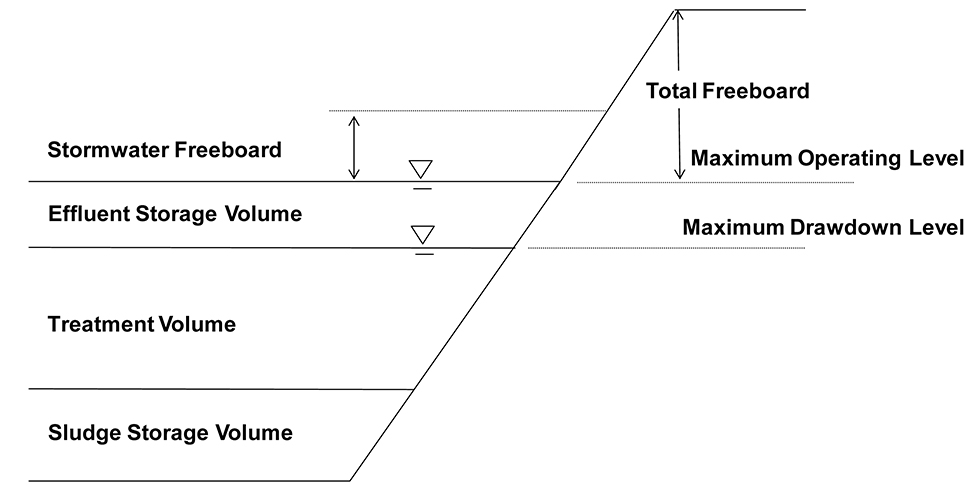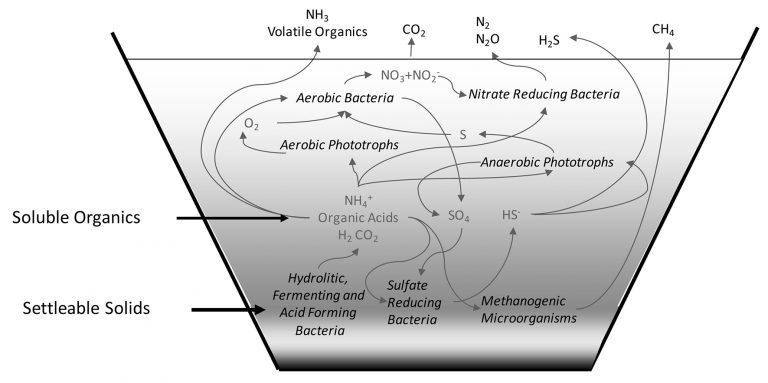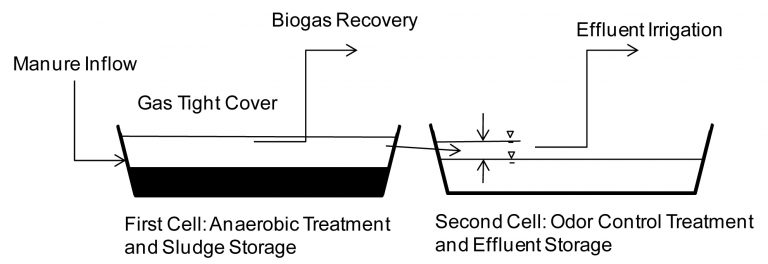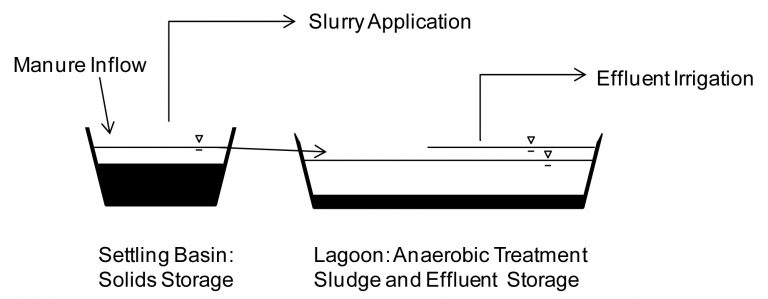Lagoons for Livestock Waste Treatment
What is a Lagoon?
A lagoon is a lined earthen basin used to treat raw organic waste, and store treated solids and liquids. Treated solids are called sludge. Treated liquids are called supernatant or effluent. A lagoon performs these functions in three volumes stacked on top of the other – sludge storage, treatment, and effluent storage (Figure 1). Freeboard (empty storage space) above the effluent storage protects the lagoon embankments from overtopping during storms. In Oklahoma, a lagoon must contain runoff from a 25-year, 24-hour storm. A 25-year, 24-hour storm is the maximum amount of daily rainfall that has a four percent chance of falling every year.
Figure 1. Half-cross-section of a single-cell waste treatment lagoon.
Sludge Storage Volume
Organic solids settle to the bottom of the lagoon and are digested at the top of the sludge layer. Further treatment takes place in the liquid portion of the treatment volume. When a lagoon is brand new, the liquid volume available for treatment is equal to the treatment volume plus the sludge storage volume. But as solids break down and become sludge, the sludge layer grows and the liquid volume above it shrinks. The liquid treatment volume should shrink to its design loading rate in 15 to 20 years. How large of a volume to be set aside for sludge storage is determined by the sludge accumulation factor. Table 1 gives the standard sludge accumulation factors for swine, poultry, and dairy operations.
Table 1. Sludge Accumulation Factors for Anaerobic and Facultative Lagoons (from ASABE, 2011).
| Sludge Accumulation Rate | ||
|---|---|---|
| Type of Waste | m3 Sludge/kg TS added |
ft3 Sludge/lb TS added |
| Swine | 0.00137 | 0.0219 |
| Poultry - Layers and Pullets | 0.00202 | 0.0324 |
| Dairy | 0.00455 | 0.0729 |
Notice that accumulation rate varies greatly for different animal species. Swine has the smallest accumulation factor. This is because swine manure particles tend to be small, settle easily, and decompose quickly. Poultry litter also contains small, quickly settling particles. But litter also contains grit, which does not decompose, so poultry litter produces more sludge than swine manure. Dairy sludge accumulates rapidly because dairy solids are generally large and not easily compressed.
Bear in mind that the accumulation rates given in Table 1 assume the material entering the lagoon is clean, and has not been pretreated. If poultry litter first passes through a grit trap before entering the lagoon, you would expect less sludge to accumulate. Soil washed off the hooves of cattle will increase the rate of sludge accumulation in a dairy manure treatment lagoon.
A long-term study of lagoons conducted in Oklahoma uncovered an interesting fact. Lagoon microbes do not like to be bothered. Contrary to what you might think, removing a little sludge each year actually makes the sludge accumulate faster. The factors given in Table 1 are based on undisturbed sludge. Mess with the sludge blanket, and the lagoon may fill up long before expected.
Treatment Volume
Lagoon treatment follows four steps:
- Manure settles to the bottom of the lagoon.
- Microbes convert settled solids into sludge and organic acids, and other soluble compounds.
- Microbes convert organic acids to methane (CH4) and carbon dioxide (CO2).
- Odorous compounds, such as H2S, NH3 and volatile organics, produced during conversion to organic acids are oxidized to less odorous compounds.
Types of Treatment
A diverse set of microbial communities perform various stages of the treatment process as shown in Figure 2. Since all the treatment steps rely on the growth of living creatures, we say that lagoons are primarily biological treatment systems. Biological processes depend on temperature, light, the presence or absence of oxygen, and the availability of food. The three types of biological treatment based on oxygen status are:
- Aerobic – organisms require oxygen to live.
- Anaerobic – organisms exist only in the absence of oxygen.
- Facultative – organisms can survive with or without oxygen.
Figure 2. Biological and chemical reactions in a lagoon.
If the lagoon has adequate aeration, or photosynthetic activity is high enough to produce measurable dissolved oxygen, it is called an Aerobic Lagoon. Lagoons that do not contain measurable dissolved oxygen are called Anaerobic Lagoons. Most livestock waste treatment lagoons are Facultative Lagoons. Facultative conditions occur in two situations. Aerobic microbes are present in the lagoon, but oxygen is consumed so quickly that it cannot be measured. An aerobic layer exists during the day when photosynthetic activity is high, but disappears during the night as microbes consume the available oxygen.
Design Factors
Lagoons are designed using two basic factors: Organic Loading Rate and Hydraulic Detention Time.
Organic Loading Rate is the amount of manure organic matter added to the lagoon each day, divided by some dimension defining the treatment volume. There are two ways to define organic loading rate:
Volumetric Loading Rate = Daily Mass of Organic Matter ÷ Treatment Volume
Surface Loading Rate = Daily Mass of Organic Matter ÷ Surface Area
The organic loading rate is a major factor determining whether lagoons will be aerobic, anaerobic, or facultative. In general, the more food available per organism, the faster oxygen will be removed. Or, the more surface area available per given amount of food, the more likely photosynthesis will create an aerobic layer.
Hydraulic Detention Time is the amount of time it takes liquid to pass through the treatment volume. It is defined as:
Hydraulic Detention Time = Daily Volume Entering Lagoon ÷ Treatment Volume
Hydraulic detention time is important because microbes floating in the treatment volume must remain there long enough to reproduce. If hydraulic detention time is shorter than the microbes’ regeneration rate, the microbial community will decline or be “washed out” of the lagoon.
Anaerobic/Facultative Lagoons
Anaerobic/Facultative lagoons are also called Stabilization Ponds. Treatment volume is based on volumetric organic loading rate. Figure 3 gives design loading rates for lagoons located within the 50 states and Puerto Rico based on USDA-NRCS guidelines. Notice that loading rate decreases as you travel north. Also notice that loading rates are halved when “low odor” conditions are needed. Halving the loading rate helps ensure that facultative conditions occur, which reduce odorous emissions considerably. These lagoons are designed to have hydraulic detention times greater than 50 to 60 days.
Figure 3. Volumetric organic loading rates in lb VS/1,000 ft3-day for uncovered, anaerobic/facultative lagoons. (USDA-NRCS, 1992a)
Covered Anaerobic Lagoons
One way to reduce the odor emitted by an anaerobic lagoon is to cover its surface with an air-tight seal. Covered lagoons are completely anaerobic since there is no way for aeration or photosynthesis to add oxygen to the treatment volume. Covered Anaerobic Lagoons are designed using both volumetric loading rate and hydraulic detention time. Figures 4 and 5 show design factors based on USDA-NRCS guidelines. Covered anaerobic lagoons are often built to capture flammable methane gas. For this reason, they are sometimes called Ambient Temperature Anaerobic Digesters. Methane producing microorganisms are notoriously slow growing, hence the importance of maintaining a minimum hydraulic detention time in the treatment volume. Volumetric loading rate for covered lagoons is higher than open surface lagoons.
Figure 4. Volumetric organic loading rates in lb VS/1,000 ft3-day for covered, anaerobic lagoons. (USDA-NRCS, 2003a)
Figure 5. Hydraulic detention time in days for covered, anaerobic lagoons. (USDA-NRCS, 2003a)
Naturally Aerated Lagoons
Photosynthetic activity maintains aerobic conditions in naturally aerated lagoons. These lagoons are designed to be aerobic throughout their depth, and are sometimes called Oxidation Ponds. Relatively shallow depths (less than 2 meters) are required to maintain these conditions. The shallow depth also means that oxidation ponds are also completely mixed by winds blowing across their surface. For this reason, they are designed without sludge storage volumes. Naturally aerated lagoons are designed based on surface organic loading rate (Figure 6). Unless pretreatment is used, naturally aerated lagoons are usually too large to be practical for manure treatment.
Figure 6. Surface organic loading rates in lbs BOD5/acre-day for naturally aerated lagoons. (USDA-NRCS, 1992b)
Mechanically Aerated Lagoons
Lagoons using mechanical devises to aerate the treatment volume are fairly rare in agriculture due to the high energy cost of aeration. These lagoons are designed on a case by case basis, using experimentally derived factors and samples of the manure to be treated.
Anaerobic Lagoons with Induced Aerobic Layers
Creating an aerobic layer on top of an anaerobic lagoon can reduce odorous emissions. This can be done by aerating the surface of the lagoon at very low rates. A second method for inducing an aerobic layer is floating a partially wetted, permeable cover on top of the lagoon. Both methods have been used on livestock waste lagoons, but sufficient data is not available to devise standard design factors.
Effluent Storage Volume
Lagoons are designed to store effluent for six months to one year. Effluent storage is a balance of what goes into the lagoon minus what goes out (Table 2). The idea is to provide enough effluent so a farmer can irrigate his crops in the spring, and maintain liquid between the maximum drawdown and operating levels the remainder of the year.
Table 2. Lagoon Liquid Balance.
| Lagoon Input | Lagoon Output |
|---|---|
| Manure | Effluent removed for irrigation |
| Flushwater | Effluent recycled as flushwater |
| Washwater | Evaporation from the lagoon surface |
| Rain falling on the lagoon surface | |
| Runoff draining into the lagoon |
The effluent balance takes place during the water year. The water year is different than the calendar year. The water year starts at the point in the year when area lakes and streams (and manure treatment lagoons) begin to fill with water. The start of the water year varies from place to place. In Oklahoma the water year generally runs from October to October. In most locations in Oklahoma, evaporation exceeds rainfall in an average year, so you may need to add extra water to the lagoon just to maintain the maximum drawdown level. Figure 7 shows the effect of rainfall minus evaporation on swine lagoon water levels in three locations in Oklahoma. A swine producer in Guymon needs to add water to his lagoon in order to maintain a constant water level. He needs to add even more to irrigate.
Figure 7. Effluent stored and lagoon liquid level at the end of each month in an average year for 3/4-acre lagoon treating manure produced by a 130 Sow Farrow-to-Finish farm with complete recycle of effluent for flushwater. (Hamilton, 2010b)
Multi-Cell Lagoon Systems
Lagoons are defined as either single-cell or multi-cell, depending on where they store effluent (Figures 1, 8, 9). The individual cells of a multi-cell lagoon are called stages. Multi-cell systems often combine anaerobic, facultative, and aerobic stages. Multi-cell lagoons generally produce better quality effluent than single cell lagoons, because each stage is designed for maximum treatment efficiency.
Covered anaerobic lagoons usually serve as the first cell of a two cell system (Figure 8). The second cell is required to protect the cover in the first cell from fluctuating liquid levels.
Figure 8. Two-cell, anaerobic/facultative waste treatment lagoon. (Hamilton, 2010c)
Often a system using a settling basin to remove manure solids before they enter into a single-stage lagoon is mistaken for a two-stage lagoon (Figure 9). The difference is biological treatment does not take place efficiently in the settling basin.
Figure 9. Single-cell lagoon with settling basin pretreatment.
Lagoon Management
There are seven keys to proper lagoon management.
- Get off to a good start. Fill at least half of the treatment volume with water before flushing any manure into a lagoon. This will ensure that the bacteria have a proper growth environment from the beginning. You can “jump start” biological treatment by seeding the new lagoon with sludge from an existing livestock treatment lagoon, or sludge from a sewage treatment plant using an anaerobic digester. Some live cultures of bacteria are also commercially available for seeding. It is also best to start a lagoon in late spring or early summer. The bacteria will have a long, warm period to begin their growth.
- Keep effluent between the maximum drawdown and the maximum operating levels. Falling below the maximum drawdown reduces treatment effectiveness. Rising above the maximum operating level increases the risk of discharge with rainfall less than the 25-year, 24-hour storm. On those rare occasions when effluent level rises above the maximum operating level, irrigate effluent to bring liquid level back into the storage zone as soon as weather permits.
- Plan to irrigate effluent at least once per year. This not only recycles valuable plant nutrients to crops, but prevents salts and other toxins from building up in the lagoon.
- Keep track of the liquid level on a weekly basis. There is no such thing as an average water year. Use the general pattern of the water year — and your best judgment — to determine when to irrigate or add water. Remember, rain causes the lagoon to rise quickly; whereas, evaporation slowly lowers the liquid level.
- Periodically check depth to sludge layer. Sludge storage volume should be included in the lagoon’s design calculations. When sludge approaches the design volume, remove half of the accumulated solids.
- Protect the lagoon embankments. The roots of woody vegetation destroy the earthwork of a lagoon. Likewise, the hooves of grazing animals accelerate erosion of the embankment. Tall weeds entice burrowing animals like muskrats to call your lagoon home. Take care of all these problems by keeping the earthwork fenced and mowed.
- Keep foreign objects out of the lagoon. The lagoon was made to digest manure. Non-degradable materials will not decompose and will take up valuable treatment volume. Extra organic materials such as spoiled milk and afterbirth will overload the lagoon which leads to odor problems.
Sources and References
ASABE. 2011. Design of anaerobic lagoons for animal waste management, ASABE Standard ANSI/ASAE EP403.4 FEB2011. St Joseph, MI: American Society of Agricultural and Biological Engineers.
Hamilton, D.W. 2010a. Sludge accumulation in two anaerobic/facultative lagoons treating swine manure from breeding farms in Oklahoma. Transactions of ASABE. 53(2):529-536
Hamilton, D.W. 2010b. Lagoon management through the water year. OK Pork Pages 14(3):4.
Hamilton, D.W. 2010c. Anaerobic digestion of animal manures: types of digesters, F-1750. Stillwater, OK: Oklahoma Cooperative Extension Service.
USDA-NRCS. 1992a. 651.1004(a) Treatment, anaerobic lagoons, pp 10-27 to 10-34 in Agricultural Waste Management Field Handbook. Washington, DC: United States Department of Agriculture, Natural Resources Conservation Service.
USDA-NRCS. 1992b. 651.1004(b) Treatment, aerobic lagoons, pp 10-35 to 10-38 in Agricultural Waste Management Field Handbook. Washington, DC: United States Department of Agriculture, Natural Resources Conservation Service.
USDA-NRCS. 2003a. Anaerobic digester – ambient temperature, Conservation Practice Standard Code 365. Washington, DC: United States Department of Agriculture, Natural Resources Conservation Service.
USDA-NRCS. 2003b. Waste Treatment Lagoon, Conservation Practice Standard Code 359. Washington, DC: United States Department of Agriculture, Natural Resources Conservation Service.
Douglas W. Hamilton
Extension Waste Management Specialist









